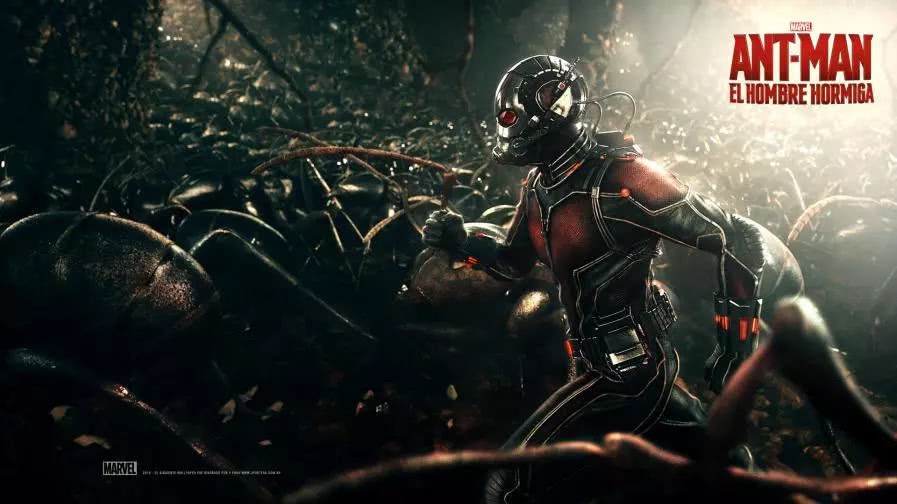Is the ability to manipulate ants in Ant Man imitating the queen?

Has your moments been scanned by the latest ants this past weekend? As early as in the first Ant-Man movie, the protagonist can shrink his body to the size of an ant and manipulate the ant to fight side by side with him. How do ants get so organized? What is their real society like?
Ant Man marches with Paraponera clavata. Picture: "Ant Man"
"real" sociality
We often compare the "society" of ants with the "society" of human beings. In fact, the two are very different. Ants and wasps, bees, termites and other animals have different social structures, which are called eusociality. True social animals have several characteristics:
1. Division of labor in reproduction, the great cause of reproduction is undertaken by specific individuals (queen ants, queen bees, etc.).
2. Generations overlap and individuals of different generations live together at the same time.
3. Cooperative parenting will take care of the offspring of other individuals in the same group.
In animals with true sociality, individuals who play different roles belong to different grades, such as queens, workers, males, etc., which is called caste in English. People familiar with the humanities and social sciences may notice that the term is also used to describe the human caste system. From the point of view of the fact that individuals from different classes play different roles and it is difficult for them to change from one another to another, there are really similarities and differences between the two.
A form of different grades of leaf-cutting ants. Picture: GameKeeper / wikipedia
So what interesting and special things will happen in these societies that are different from ours?
Why do you have to take care of the rivers and mountains on the basis of your ability?
In the ant colony, the queen is the center of the colony, but she does not monopolize power, which does not mean that she is a pro-people cadre who "follows the mass line", but because she does not care about other ants at all. Unlike societies commanded by leaders, such as wolves or humans, the societies of ants and other true social animals are in a state of self-organization. Ants have no leader or the ability to co-ordinate the overall situation and direct actions, but simple pheromone-based interactions between individual ants can accomplish complex behaviors.
Marching ants build huge tents at the base of the trees as camps; each worker with poor eyesight only grabs his companion, but eventually builds a building made up of countless ants. this is the self-organizing behavior of true social animals. Picture: Geoff Gallice / wikimedia
Whether foraging, attacking or defending their homes, the worker ants do it spontaneously in a state of self-organization, and the queen does not care at all. She didn't run away in chaos until the ant's nest was breached by the enemy.
Ants of the genus Solenopsis build bridges for ant people. Picture: "Ant Man"
But the queen is not a simple breeding machine, many ants are not a single queen, but have multiple queens at the same time. The "palace fight" between these queens is no less than the TV series we watch. High-status queens have higher reproductive rights and more offspring, and in some species, high-level queens also have a set of special corporal punishment rituals for low-level queens, which can be said to be amateur civil wars.
Labor is infinitely good, who says it can't be born?
Contrary to the perception of many people, workers among ants can actually lay eggs, and the eggs can grow up smoothly. The sex determination mechanism of ants and true social bees is very special: fertilized eggs (diploids) combined with eggs and sperm develop into females and unfertilized eggs (haploids) develop into males. The queen stores male sperm in seminal vesicles and controls the sex of her offspring by deciding whether or not to fertilize the eggs when laying eggs. On the other hand, workers can only lay unfertilized eggs and naturally only develop into males.
The main task of the queen is to give birth. Picture: Gary D. Alpert / wikipedia
If the queen dies, workers who have lost their future tend to lay a large number of eggs and reproduce a large number of males as their last stubbornness. It's like saying, "this is my last chromosome, please take it!"
There are also some ants of the genus Trichosanthes that have no queen at all, and their workers have the ability to mate and reproduce completely. Worker ants have a pair of wing bud-like structures on their breasts, and under the control of this structure, they can mate and reproduce like queens. However, there is only one worker ant who plays the role of queen in the nest, and it will bite off the wing buds of other workers and "castrate" manually, which can be said to be very deliberate.
A kind of double-thorn ant, the pair of small black spots on the chest is the wing-bud-like structure that controls the reproductive power. Picture: April Nobile / wikimedia
This is not what we agreed on.
Eggs, pupae and larvae are the future of the ant colony, and if anything happens, the worker's first reaction is to move them to a safe place. But they also have another honorable status-grain reserves.
A large part of the eggs of ants are not used for hatching, but for eating. These eggs are called nutritious eggs. When the new queen built an ant colony from scratch, she had nothing but a nutritional reserve, so in the absence of food, their trick to raising children was to feed their eggs to their larvae.
When the famine comes and the ant colony has nothing to eat, eggs, pupae and larvae are precious food. The larvae and eggs will be eaten first, because the pupa does not consume resources and may be feathered into precious labor tomorrow.
When the nest is exposed, workers who immediately begin to carry their offspring. Picture: worms singing in the mountains
There are parasites in society.
Some species of ants do not engage in production themselves and specialize in plundering the pupae and larvae of other ants as their own labor force. This "slave keeping" behavior has evolved independently among ants for many times, the most famous of which is a member of the genus Hummer. Their jaws are specialized in the shape of a sickle, designed to attack other ants. Because their jaws are so specialized that they can't take care of themselves, they can't even eat without the help of slaves. Fierce ants regularly plunder other ants (usually similar ants), snatch larvae and pupae, eat some of them as food, and wait for them to become workers and serve themselves.
The fierce ants that are looting. Picture: James C. Trager / wikipedia
Although it sounds majestic, the essence of this "slavery" behavior is actually parasitic behavior. Like other parasites, ants can't survive without their hosts. But this kind of parasitism is also very special, not an individual parasitic on another individual, but an insect society parasitic on other societies, so they also get a special name-social parasite.
In addition to high-profile and belligerent ants like the fierce ants, there are other low-key groups of ants that are socially parasitic. Some of them sneak into other ant colonies to cheat food and drink, and some even abandon workers, leaving only queens and males, and the above-mentioned double-thorn ants are the two extremes of evolution. This kind of parasitic queen will stick to the host queen and lay her eggs with the host, and the deceived worker ants think that they are all their own families who have worked hard to raise them.
A superorganism that merges parts into a whole.
Many behaviors and survival strategies of social insects such as ants and wasps may seem unthinkable to us, but if we treat the whole nest group as a whole organism, their behavior becomes very similar to that of other organisms. So they are often described as superorganisms (Superorganism). In a superorganism, the individual is not important, the larvae can be reabsorbed like fat, the soldiers who die when they encounter the enemy are just the white blood cells of the superorganism, and the food brigade is the outstretched hand of the superorganism.
Eciton burchellii on the march. Picture: Geoff Gallice / wikipedia
When the queen dies, superorganisms called ant colonies die, but some colonies are theoretically permanent. Some ants of the genus Ant and Little Ant have not only many queens, but also females who continue to be assigned as new queens, with endless children and grandchildren.
Although there is only one queen, the ant colony, represented by army ants, holds a "general election" every few years to select a suitable crown prince from the queen's daughter to take the place of the old queen. So for these ants, their colony history is as long as the age of the species. As long as there is their place in the earth's ecosystem, these superorganisms can pass on the same bloodline forever.
This article is a special contribution to species Calendar, from the author of species Calendar @ Shenshan Bug Yin.
- Prev

These six succulent varieties will become the envy of the neighbors of the waterfall.
The 26th? Qian Yan love succulent love life (WeChat: duorou91) reply to "Community" and 20W meat friends to bask together! Backstage reply "delicious meat", "summer, watering, leaf insertion, soil, disinfestation, black rot" view phase.
- Next

The lazy foodie looks unexpectedly high.
Haliotis iris, from the genus Haliotis of the family Abalone. If you have met it at the dinner table, you must have been impressed by its wide, dark underlegs. But you know what, in order to come to you...
Related
- Wuhan Hospital Iron Tree Blooming Result Was Instantly Frightened by the Gardener Master
- Which variety of camellia is the most fragrant and best? Which one do you like best?
- What is the small blue coat, the breeding methods and matters needing attention of the succulent plant
- Dormancy time and maintenance management of succulent plants during dormancy
- Minas succulent how to raise, Minas succulent plant pictures
- What are the varieties of winter succulent plants
- How to raise succulent plants in twelve rolls? let's take a look at some experience of breeding twelve rolls.
- Attention should be paid to water control for succulent plants during dormant period (winter and summer)
- Watering experience of twelve rolls of succulent plants
- Techniques for fertilizing succulent plants. An article will let you know how to fertilize succulent plants.

